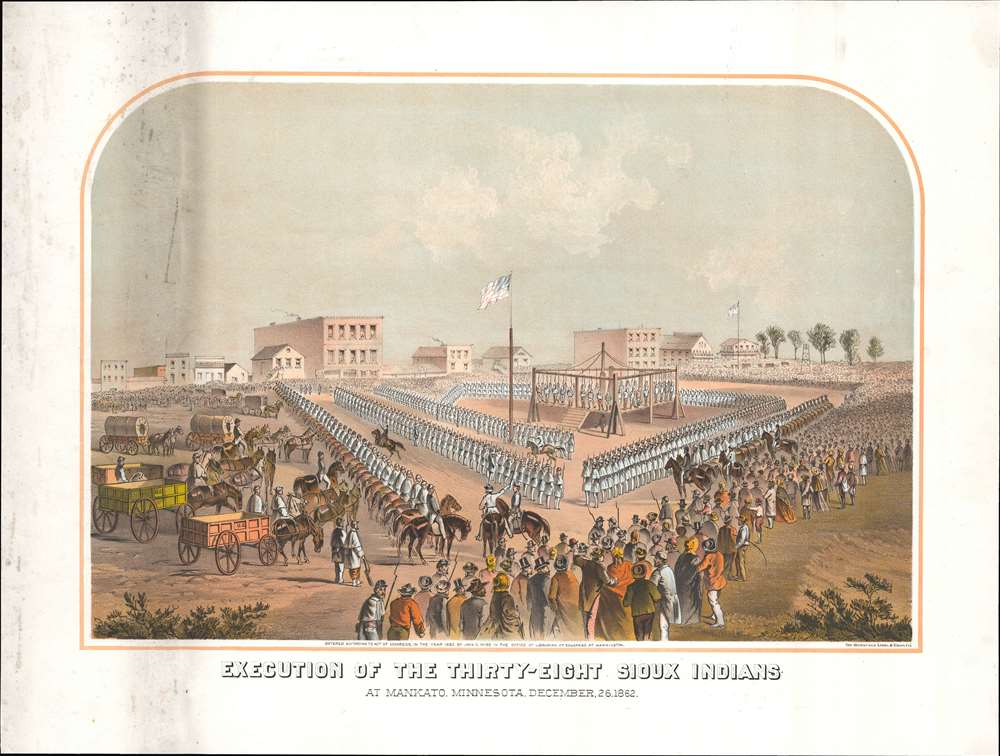This item has been sold, but you can get on the Waitlist to be notified if another example becomes available, or purchase a digital scan.
1883 Wise View of 1862 Mass Execution of Sioux, U.S.-Dakota War
SiouxExecution-wise-1883
Title
1883 (dated) 12 x 18 in (30.48 x 45.72 cm)
Description
A Closer Look
This print portrays the execution by hanging of 38 Sioux (Dakota), who are surrounded by a ring of troops and residents of Mankato. The executions took place in the wake of the Dakota War of 1862, discussed below. A seminal event in the westward expansion of the United States, the Dakota War and its aftermath saw the expulsion of 'hostile Sioux' from the Upper Midwest.Dakota War of 1862
The Dakota War was one of the most intense and bloody episodes of all the American Indian Wars. Taking place over the period of a few weeks in August and September of that year, the conflict resulted in hundreds of deaths and thousands of refugees. The overriding cause was a steep increase of white settlers to Minnesota, from some 6,000 in 1850 to over 170,000 a decade later. Meanwhile, the Dakota were confined to ever-smaller reservations and encouraged to take up farming to assimilate into white society. Tensions were increased by unscrupulous American traders and 'Indian agents' who cheated Native Americans to seize land and resources. The Dakota ('Sioux' in contemporary American sources) were also pressured by crop failures leading to starvation in the months before the conflict.In mid-August 1862, when the government was late in annuity payments and Indian agents refused to lend the Dakota money, some Dakota attacked agents and frontier traders. Recognizing that a military response was inevitable, Dakota leaders banded together in a larger attack on white frontier settlers, eventually killing nearly 360 and taking hundreds prisoner (many being 'mixed blood' settlers with Dakota relatives).
The response of the state's political establishment was to launch a broad campaign of retribution. Assistance from the federal government was limited given the ongoing American Civil War (1861 - 1865), leaving the response to volunteer and militia, who initially fared poorly. Eventually a force of federal troops from Minnesota who had suffered defeat at the hands of the Confederates, including returned prisoners of war, were added to the volunteer and militia forces and able to overwhelm a much smaller Dakota force at the Battle of Wood Lake, effectively ending the war.
Afterwards, 212 Dakota prisoners were sentenced to death, but despite widespread popular support for the executions and attempts by mobs to seize and lynch the prisoners, President Lincoln reviewed their cases and decided to reprieve those who had not verifiably participated in rape or massacres. In the aftermath of the violence, the U.S. Congress abolished the eastern Dakota and Ho-Chunk (Winnebago) reservations and moved the 'hostile Sioux' to reservations further west, part of the blanket implementation of reservations for native peoples. Meanwhile, many of the settlers who fled in 1862 never returned to the frontier. On December 26, 2019, Minnesota Governor Tim Walz issued an apology for the 1862 hangings and other violence enacted against the Dakota.
Publication History and Census
This view was published in 1883 by John C. Wise and was printed by the Milwaukee Lithographing and Engraving Company. Wise, with a business partner surnamed Clark, published an earlier 1865 edition attributed to artist Otto Knirsch and printed by Culver Page and Hoyne. Both lithographic prints appear to be based on an earlier, smaller engraving made in 1863, soon after the event for Frank Leslie's Illustrated. The present edition is held by eight institutions and is scarce to the market.CartographerS
John C. Wise (fl. c. 1882 - 1883) was a newspaper publisher in Mankato, Minnesota, best known for his publication of a print showing the execution of 38 Dakota warriors in the wake of the Dakota War of 1862. More by this mapmaker...
Milwaukee Lithographing and Engraving Company (c. 1872 - 1920) was a printing company based in its namesake city that is often considered to be the first modern printer in Milwaukee. The firm was founded by the German-born Henry Seifert, who had worked as a lithographer and printer for several years before immigrating to Milwaukee in 1852 and continuing his work in the field. He and two partners founded the Milwaukee Lithographing and Engraving Company in 1872 and in 1876 they built a three-story plant in downtown Milwaukee. Seifert stepped down as the company's president in 1899 and it appears to have ceased operations around 1920. Learn More...

